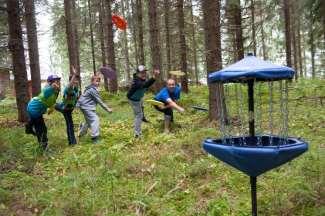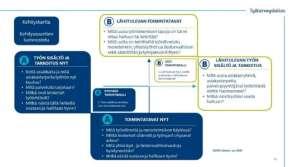
3 minute read
Welding Door Frames with Collaborative Robot
from Oamk_telulainen - Oamkin Tekniikan ja luonnonvara-alan yksikön yhteisnumero 2021 - nro 4 - vol 2
by Oamk_telu
Writers: Mari Arvola, Sari Ek, principal lecturer Kai Jokinen Photos: Mari Arvola, project planner Jari Rauma School of Engineering and Natural Resources Oulu University of Applied Science
This article is based on the results of a product development project in co-operation with a local metal and glass construction company. It was carried out by Oulu University on Applied Science (OAMK) within further education of Lean and Robotics. PP-Fasadi Oy was interested in a possibility to weld steel door frames with a robot.
Advertisement
The aim of the project was to utilize the Jansen welding table for welding joints of steel door frame mitres with a collaborative robot. The main objective was to improve quality and shorten the manufacturing time compared to manual welding. This could be achieved by welding all seams in a row without tack welds and their sanding. During the project it was necessary to familiarize with planning of a robot cell and safety factors. Programming the UR10e collaborative robot and using the Kemppi A7 MIG welding equipment played the major part in the project. The robot’s movements and welding parameters were optimized in the welding laboratory at University of Oulu. At the end of the project the welding cell was demonstrated in action at the company premises.
Finished robotic welding cell at PP-Fasadi Oy
The robot senses the position of the corner to be welded.
Technical realization
The UR10e robot has a build-in force control that recognizes collisions. Robotiq has developed a method that uses the force control to locate the positioning of the part. The application is called Find and Apply Contact Offset. The process starts by the robot touching the part from three different points to determine the location of the part. After that the robot automatically adapts the welding seams to the right place. The position locating application enables the table to be roughly aligned by marking tapes in its pedestal. Since the table is very heavy, it does not move easily after it has been turned. For this reason, there was no need to secure the position with an additional latch for the welding process. The welding program and part locating were carried out separately for both the left and right corners, to minimize problems caused by the margin of error in the location of the part. Welding the mitre joints without tack welds worked very well. The door frame kept its cross-measure, and it did not twist when let loose from the table. The welding order was implemented as follows: the vertical weld downright, the underside weld from its inner corner towards the outer and the upper side weld from inner corner towards the outer. The wire cutting process to 10 mm length was carried out after welding each corner.

Welding results
The robot’s teach pendant with a touch screen is not the most practical way to start repetitious welding processes. Because of this it was decided to use push buttons fitted for the pendant’s pedestal. An emergency stop button was also fitted for the same pedestal. A welding or cleaning process can be chosen from push buttons by the operator.

Robot’s teach pendant and push buttons
The conclusion of the project was that steel door frames can be welded by a collaborative robot. This requires that the robot has a locating application for corner positioning in order not to make any changes in the Jansen 499.007 rotating welding table.
Further development
It would be preferred to change the welding table’s original screw clamps to quick-change clamps. They are faster to use and lower than the originals, so the robot does not collide with them so easily. By changing the table motor to a stepping motor or servomotor with a positioning device, it would be possible to let the robot know the exact position of the corner. This way there would be no need to use the locating application for corner positioning and the welding process could speed up as much as by 25%.
By lifting the wire feeder system above the robot, it is possible to ease the robot’s movements. Crossbars and hinges could be welded with a robot by making jigs where they can be attached for the welding. To ensure that the robot can reach all seams, it is recommendable to purchase a linear axel on which the robot can move further and closer to the table when needed.










